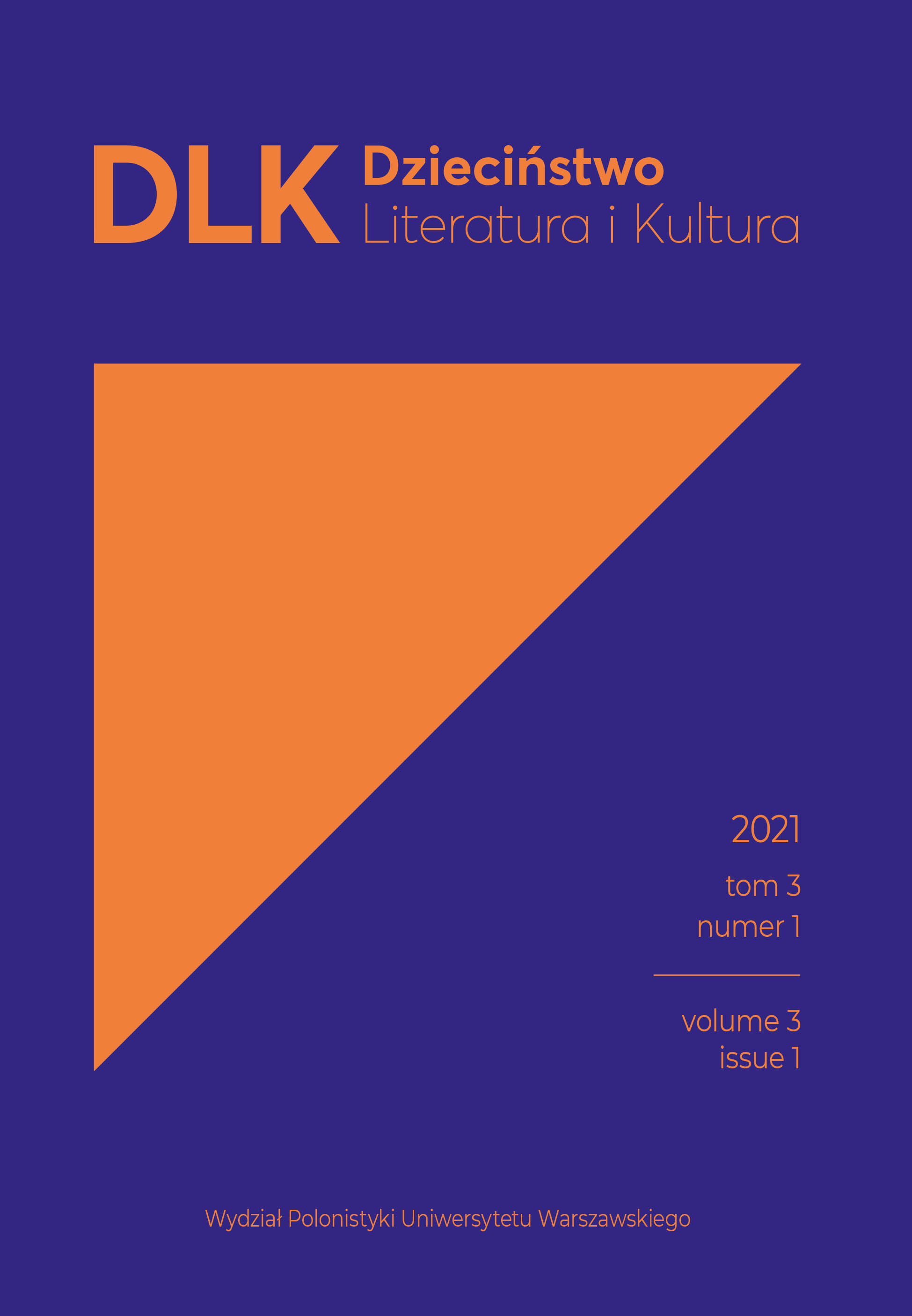The Doctor from the Ghetto: Images of Janusz Korczak in Children’s Books
Abstract
Henryk Goldszmit – a writer, doctor, and educator, publicly known as Janusz Korczak, and in the 1930s also as the ‘Old Doctor’ speaking to children on the radio – for the sake of his rich professional life, his work to protect children’s rights, as well as his death in the Treblinka death camp, became an unquestionable symbol of the faithful orphan caretaker, determined to accompany his charges to the end despite the possibility of personal rescue. The paper, on one hand, is an attempt to present this tragic story and, on the other, to critically discuss Korczak’s images emerging from children’s books. Publications analysed here are books released in Poland in the last decade: Po drugiej stronie okna. Opowieść o Januszu Korczaku [The Other Side of the Window: A Tale about Janusz Korczak] by Anna Czerwińska-Rydel (2012), Jest taka historia. Opowieść o Januszu Korczaku [There is This Story: A Tale of Janusz Korczak] by Beata Ostrowicka (2012), Pamiętnik Blumki [Blumka’s Diary] by Iwona Chmielewska (2011), Ostatnie przedstawienie panny Esterki. Opowieść z getta warszawskiego [Miss Esterka’s Last Show: A Tale from the Warsaw Ghetto] by Adam Jaromir and Gabriela Cichowska (2014), and a work for older children, The Book of Aron by Jim Shepard, recently translated into Polish.
Keywords
Adam Jaromir; Anna Czerwińska-Rydel; Beata Ostrowicka; Gabriela Cichowska; Warsaw Ghetto; Iwona Chmielewska; Janusz Korczak; Jim Shepard; Polish children's literature; war; Holocaust; Jews
Supporting Agencies
The article is based on a paper presented during the 29th Varsovian Session “Warsaw in Children’s and Young Adult Culture” and financed by the Warsaw Public Library – Central Library of Mazovia Province.
References
Adler, D. (2002). A hero and the Holocaust: The story of Janusz Korczak and his children. Holiday House.
Barszczewska, L., Milewicz, B. (wyb. i oprac.). (1981). Wspomnienia o Januszu Korczaku. Nasza Księgarnia.
Belfer, I. (2015). Ha-Ish she-yada‘ le-ehov yeladim. Ben-Gal.
Bogacki, T. (2009). The Champion of children: The story of Janusz Korczak. Farrar, Straus and Giroux.
Brach-Czaina, J. (2018). Szczeliny istnienia (wyd. 3). Dowody na Istnienie.
Chmielewska, I. (2011). Pamiętnik Blumki. Media Rodzina.
Cohen-Janca, I. (2015). Le dernier voyage : le docteur Korczak et ses enfants. Les Éditions des Éléphants.
Czerwińska-Rydel, A. (2012). Po drugiej stronie okna. Opowieść o Januszu Korczaku. Muchomor.
Domańska, E. (2005). Mikrohistorie. Spotkania w międzyświatach. Wydawnictwo Poznańskie.
Domańska, E. (2006). Historie niekonwencjonalne. Refleksja o przeszłości w nowej humanistyce. Wydawnictwo Poznańskie.
Hirszfeld, L. (1946). Historia jednego życia. Czytelnik.
Jaromir, A., Cichowska, G. (2014). Ostatnie przedstawienie panny Esterki. Opowieść z getta warszawskiego. Media Rodzina.
Korczak, J. (1928). Prawo dziecka do szacunku. Wydawnictwo J. Mortkowicza.
Korczak, J. (1938). Uparty chłopiec. Życie Ludwika Pasteura. Wydawnictwo J. Mortkowicza.
Korczak, J. (2012). Pamiętnik i inne pisma z getta (M. Ciesielska, oprac. przyp., J. Leociak, posłowie). W.A.B.
Leociak, J. (2008). Jeśli zdążę, napiszę apologię wszy. O insektach w tekstach Korczaka. Res Publica Nowa, 21(1–2), 84–92.
Marrin, A. (2019). A light in the darkness: Janusz Korczak, his orphans, and the Holocaust. Alfred A. Knopf.
Meirieu, P. (2012). Korczak : pour que vivent les enfants. Rue du Monde.
Mortkowicz-Olczakowa, H. (1949). Janusz Korczak. Wydawnictwo J. Mortkowicza.
Olczak-Ronikier, J. (2011). Korczak. Próba biografii. W.A.B.
Ostrowicka, B. (2012). Jest taka historia. Opowieść o Januszu Korczaku. Literatura.
Rybak, K. (2019). Dzieciństwo w labiryncie getta. Recepcja mitu labiryntu w polskiej literaturze dziecięcej o Zagładzie. Wydawnictwa UW.
Shem-Tov, T. (2012). Ani lo ganav. Kinneret Zmora-Bitan Dvir.
Shepard, J. (2019). Księga Arona (Z. Szachnowska-Olesiejuk, tłum.). Sonia Draga. (wyd. oryg. 2015).
Tagore, R. (1922). Poczta (J. Stur, odtw.). Monsalwat.
Topolski, J. (2008). Jak się pisze i rozumie historię. Tajemnice narracji historycznej. Wydawnictwo Poznańskie.
Wajda, A. (reż.). (1990). Korczak [film]. Zespół Filmowy Perspektywa, Regina Ziegler Filmproduktion, Telmar Film International, Erato Films, ZDF, BBC Films.
White, H. (2009). Proza historyczna (R. Borysławski, tłum., E. Domańska, red.). TAiWPN Universitas.
Witkowska, A. (2009). Między gettem a niebem, czyli o ostatnim przedstawieniu w Domu Sierot Janusza Korczaka. Kwartalnik Historii Żydów, 3(231), 312–326.
Witkowska-Krych, A. (2017). Główny Dom Schronienia. Zagłada Żydów. Studia i Materiały, 13, 372–398. https://doi.org/10.32927/ZZSiM.364.
Witkowska-Krych, A. (2019). Mniej strachu. Ostatnie chwile z Januszem Korczakiem. Wydawnictwo Akademickie Dialog.
Wójcik-Dudek, M. (2016). W(y)czytać Zagładę. Praktyki postpamięci w polskiej literaturze XXI wieku dla dzieci i młodzieży. Wydawnictwo UŚ.
University of Warsaw, Emanuel Ringelblum Jewish Historical Institute Poland
https://orcid.org/0000-0001-8510-9475
Agnieszka Witkowska-Krych – PhD, works at the Institute of Polish Culture of the Faculty of Polish Studies at the University of Warsaw as well as at the Emanuel Ringelblum Jewish Historical Institute (Poland). Her research interests include anthropology of everyday life, history and culture of Polish Jews, and the fate of the Warsaw Ghetto and its inhabitants. Contact: a.witkowska-krych@uw.edu.pl.

This work is licensed under a Creative Commons Attribution 4.0 International License.
Open Access Policy
All articles presented on the pages of ”Dzieciństwo. Literatura i Kultura” are published in open access under a Creative Commons license - Attribution 4.0 International (CC BY 4.0). It means that:
- they can be made available and quoted under the condition of explicit and clear indication of the author/authors of the referenced text;
- you cannot use legal or technological means that would limit others in using the text under the terms of the license.
More information: https://creativecommons.org/licenses/by/4.0/





